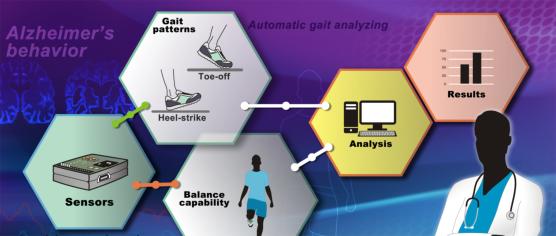Hsu, Y., Chung, P., Wang, W., Pai, M., Wang, C., Lin, C., Wu, H., Wang, J.

Despite patients with Alzheimer’s disease (AD) were reported of revealing gait disorders and balance problems, there is still lack of objective quantitative measurement of gait patterns and balance capability of AD patients. Based on an inertial-sensor-based wearable device, this paper develops gait and balance analyzing algorithms to obtain quantitative measurements and explores the essential indicators from the measurements for AD diagnosis. The gait analyzing algorithm is composed of stride detection followed by gait cycle decomposition so that gait parameters are developed from the decomposed gait details. The balance is measured by the sway speed in anterior-posterior (AP) and medial-lateral (ML) directions of the projection path of body’s center of mass (COM). These devised gait and balance parameters were explored on twenty-one AD patients and fifty healthy controls (HCs). Through our experiments, the proposed wearable device demonstrated its effectiveness as a tool to estimate strides of the subjects, to measure spatial and temporal gait parameters, and to assess balance capability. Experimental results indicated that to perform an additional cognitive task requiring much more cognitive and attention functions leads to that the AD patients presented a significantly greater difference of the gait parameters between single-task and dual-task than the HC group. In the balance ability tests, AD patients also presented a significant larger average sway speed in ML direction compared with the HCs during right foot tandem stand with close eye and stand on right foot. The results obtained from this paper suggest that the inertial-sensor-based wearable device reveals promising potential for gait and balance capability analysis and is worth of further in-depth research to identify gait and balance parameters in mild AD patients, so as to be served as indicators for early diagnosis of AD, and also as predictive clinical factors of progression towards dementia in this population.
Tags: Acceleration, Accelerometers, Algorithm design and analysis, Angular velocity, Informatics, Legged locomotion, Support vector machines

